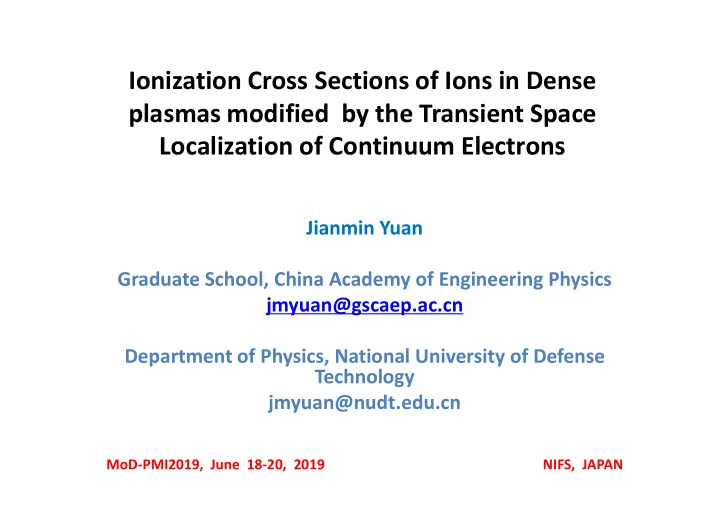

Ionization Cross Sections of Ions in Dense plasmas modified by the Transient Space Localization of Continuum Electrons Jianmin Yuan Graduate School, China Academy of Engineering Physics jmyuan@gscaep.ac.cn Department of Physics, National University of Defense Technology jmyuan@nudt.edu.cn MoD-PMI2019, June 18-20, 2019 NIFS, JAPAN
Introduction Nature 517 , 56 (2015)
Introduction Mean free path: l = u P εl is the radius wave function of n free electron and is renormalized. In free space In plasma atom æ ö ( ) exp - r ( ) = P old r P e l r ç ÷ e l è l ø 2 ˆ p T ij i j
Opacity with Debye like screening N - bb bf ff hv / kT = A n n n - K ( h ) ( h ) ( h ) ( 1 e ) K n sc A Z 1 ˆ = - 2 H [ c p mc ] ( ) r f i r r i i j i i ij 1 1 r r R R = = i i 0 0 ( ) ( ) r r 4 4 r r r r ( ) ( ) r dr r dr f i 1 1 f 1 1 r 0 r i i 2 1 p dp = ( r ) f ( ) 2 æ ö p ( r ) 2 2 4 - 2 - - p c c c U r 0 ç ÷ exp 1 ç ÷ k T è ø B 2s 2 2p 6 3s, 2s 2 2p 5 3s, 2s 2 2p 4 3s
Opacity with Debye like screening
Finite quantum coherence length for the thermal continuum electrons
Finite quantum coherence length for the thermal continuum electrons
Finite quantum coherence length for the thermal continuum electrons
Finite quantum coherence length for the thermal continuum electrons
Finite quantum coherence length for the thermal continuum electrons Te=194 eV, n e =4 10 22 /cm 3
Comparison with experiment using CSD by Saha equation Expt.: J. Bailey et al.. Nature 517, 56 (2015). Theo. (Isolated): using free-atom data Theo. (w/i localization): using atomic data with electron localization effect with electron localization effect
Nuclear thermal motion driven electronic states Quantum Molecular Dynamics QMD: – Electronic states are described by using DFT – ions’ moving on smooth potential surface is described by Newton’s equation Langevin molecular dynamics in condensed matter and material sciences and material sciences – ions in Langevin equation = - M R F M R N I I t I I I represents the contribution of thermostat for controlling the t temperature of the system. 14
Nuclear thermal motion driven electronic states Simulation for Sandia’s experimental plasma conditions
Nuclear thermal motion driven electronic states The electron density distribution around the ions in the cell 38.9 a.u.
Nuclear thermal motion driven electronic states DFT based calculations with 16 atoms in a unit cell
Nuclear thermal motion driven electronic states Two typical atoms chosen in the cell, one is close to another and one is separated from others.
Comparison with experiment using diagnosed CSDs CSDs by Saha equation and diagnostics Ion 195eV 181eV 169eV 164eV Diag Saha Diag Saha Diag Saha Diag Saha nose Eq. nose Eq. nose Eq. nose Eq. 13 0 0 0.02 0.0 0.05 0.0 0.0 0.0 14 0.01 0 0.07 0.00 0.05 0.00 0.0 0.0 3 4 15 15 0.01 0.01 0.01 0.01 0.10 0.10 0.22 0.22 0.20 0.20 0.03 0.03 0.0 0.0 0.00 0.00 2 5 16 0.14 0.11 0.15 0.16 0.18 0.18 0.28 0.07 17 0.32 0.30 0.25 0.36 0.24 0.39 0.30 0.27 18 0.28 0.35 0.23 0.32 0.17 0.30 0.18 0.40 19 0.18 0.18 0.12 0.12 0.02 0.09 0.01 0.22 20 0.01 0.04 0.01 0.02 0.01 0.01 0.04 0.04 21 0.05 0.0 0.05 0.00 0.08 0.0 0.03 0.00 1 3 22 0.0 0.0 0.0 0.0 0.00 0.0 0.16 0.0
Electron impact ionization processes
Electron impact ionization processes
Electron impact ionization processes
Electron impact ionization processes
Electron impact ionization processes
Summary 1. Here we propose the notion of a transient space localization of electrons produced during the ionization of atoms immersed in a hot dense plasma. 2. A theoretical formalism is developed to study the wavefunctions of the continuum electrons that takes into consideration the quantum de-coherence caused by coupling with the plasma environment. 3. We find that the cross section is considerably enhanced 3. We find that the cross section is considerably enhanced compared with the predictions of the existing isolated-atom model. 4. And thereby partly explains the big difference between the measured opacity of Fe plasma and the existing standard models for short wavelengths, and also explains the big gap between the extracted electron impact ionization rates from laser heated Mg plasma and the calculated values using the existing models.
Acknowledgements: Colleagues: Pengfei Liu (刘鹏飞), Cheng Gao (高诚), Dongdong Kang (康冬冬), Yong Hou (侯永), Jiaolong Zeng (曾交龙) Supported by: Supported by: Science Challenge Project and National Natural Science Foundation of China
Recommend
More recommend